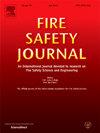Effect of discharged pressure for fire extinguishing agent performance (HFC-125) considering fire accident in the aviation
IF 3.4
3区 工程技术
Q2 ENGINEERING, CIVIL
引用次数: 0
Abstract
HFC-125 (fire extinguishing agent) affects the charged pressure inside the vessel depending on the ambient temperature. Aviation fire extinguishing systems are exposed to ambient temperatures ranging from −50 °C to 200 °C. In this study, experiments were conducted at changing charged pressure, high ambient temperature, and low ambient temperature under the assumption that the pressure inside the vessel changes depending on the ambient temperature. The charged pressure range is 3.61 MPa–4.90 MPa. It was confirmed that as the charged pressure increased, the discharge time decreased from 2.19 s to 1.67 s and pressure recovery occurred. The charged pressure range where pressure recovery occurs was predicted to be 2.63 MPa–5.12 MPa. The pressure recovery showed the largest pressure difference at 4.21 MPa of charged pressure. In the high temperature experiments, the ambient temperatures were 56 °C and 76 °C, and chalked flow occurred above 56 °C. This means that the discharge rate is constant above 56 °C. In low temperature experiments, HFC-125 was lowered to below −30 °C and discharged at −14 °C and −18.8 °C. The low temperature experiment results showed that pressure recovery did not occur at low temperatures due to unsaturation of dissolved nitrogen. Additionally, oscillations also occurred, resulting in discontinuous discharge rate.

航空火灾事故中排放压力对灭火剂(HFC-125)性能的影响
HFC-125(灭火剂)会根据环境温度影响容器内的充注压力。航空灭火系统暴露在环境温度范围为- 50°C至200°C。在本研究中,在假设容器内压力随环境温度变化的情况下,分别在改变充注压力、高环境温度和低环境温度下进行实验。充注压力范围:3.61 MPa ~ 4.90 MPa。结果表明,随着充注压力的增大,放电时间由2.19 s缩短至1.67 s,并出现压力恢复。预测发生压力恢复的充注压力范围为2.63 MPa - 5.12 MPa。在充注压力为4.21 MPa时,压力恢复差最大。在高温实验中,环境温度分别为56℃和76℃,在56℃以上发生粉笔状流动。这意味着放电速率在56°C以上是恒定的。在低温实验中,HFC-125降至- 30℃以下,在- 14℃和- 18.8℃下放电。低温实验结果表明,由于溶氮不饱和,在低温条件下不发生压力恢复。此外,振荡也会发生,导致放电速率不连续。
本文章由计算机程序翻译,如有差异,请以英文原文为准。
求助全文
约1分钟内获得全文
求助全文
来源期刊

Fire Safety Journal
工程技术-材料科学:综合
CiteScore
5.70
自引率
9.70%
发文量
153
审稿时长
60 days
期刊介绍:
Fire Safety Journal is the leading publication dealing with all aspects of fire safety engineering. Its scope is purposefully wide, as it is deemed important to encourage papers from all sources within this multidisciplinary subject, thus providing a forum for its further development as a distinct engineering discipline. This is an essential step towards gaining a status equal to that enjoyed by the other engineering disciplines.
 求助内容:
求助内容: 应助结果提醒方式:
应助结果提醒方式:


